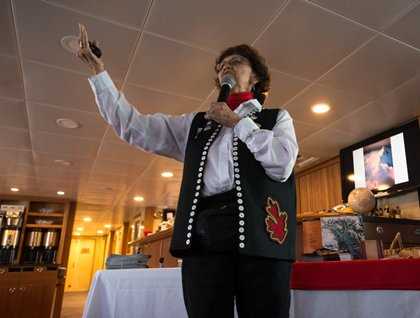As stories passed down over the generations relay, the late 1600s was a time of glacial advance here in Glacier Bay National Park. This massive fjord system, as we saw it today, however, did not exist in the 1600s. The 65 miles of silt-laden water we transited overnight to get to the northernmost reaches of the park were filled with advancing glaciers and salmon-rich streams when a group of Tlingit natives lived at the foot of those advancing glaciers. Their homes were on land that has since been ground down and flooded by hundreds of feet of seawater as the glaciers retreated. Today we floated over their ancestral homeland, aboard National Geographic Sea Bird, with an extended family member of those early Alaskans. Alice Haldane was one of our guests today and, as a member of the Tlingit community, was aboard to share with us some of the stories passed down by her people over the generations.
Our morning started over 60 miles from where Alice’s ancestors once lived, near the face of the Johns Hopkins Glacier. As one of the only advancing bodies of ice in the northern hemisphere the waters at the foot of this ice wall were relatively ice free, allowing exceptional access to its colossal face and the hundreds of harbor seals lying on what ice floated near the glaciers terminus.
Glaciers were the theme of the morning as the Johns Hopkins, Margerie, Lamplugh, and Grand Pacific were all visited before lunch. Relics of the massive amounts of ice that once pushed Alice’s ancestors out of the bay, these glaciers are all responding to their subsequent retreat in different ways. The Margerie is stable, the Grand Pacific is buried under rock and quickly deflating, the Lamplugh is pulling away from the sea for the first time in thousands of years, and the Johns Hopkins, since its source is near the 15,000ft peaks of the Mt. Fairweather range, has advanced a few hundred feet since 1929. For 45 minutes we listened to the fractured face of the Margerie pop and groan before starting our 65-mile journey back down fjord.
Russell Cut ushered in our first encounter with Glacier Bay brown bears. Through curtains of fog the dark outline of a lone four-legged animal was all we could decipher at first. Closing in to within 200 meters we could verify the wet fur of a 4-5 year old bear foraging just above the intertidal zone. A few miles further south, in Tidal Inlet, another bear emerged from the grass near shore. This much larger individual was the darkest brown bear any of the naturalists had ever seen. Nearly black in coloration, this healthy male was discernable as a brown bear mostly from the characteristic lump of muscle between its shoulder blades.
Moving south, we continued into Geikie Inlet on the hunt for true black bears. With stratified, wispy clouds hugging these more well-established forests, we were not nearly as concerned by the eventual lack of black bear sightings.
Our last stop was at South Marble Island, where the birds stole the show. Huge flocks of Glaucous-winged gulls and black-legged kittiwakes peppered the sky and sea while a Peregrine falcon was on the hunt and an epic knock-out battle between two tufted puffins drew the entire ship’s attention for nearly 10 minutes. Locked in a seeming death grip, these two diving birds were intertwined at the bill for a couple of rounds before the attacked attempted to flee. One full circle around our ship, these two birds, no bigger than a loaf of bread each, were paddle-wheeling as fast as their stubby wings would allow, with the outcome leading to both birds diving out of sight and popping up, eventually, at a safe distance from each other. Whatever sparked such a duel is a mystery to us all.
Back at the ranger station in Bartlett Cove, we were yet again near the place Alice’s ancestors once called home. Confident in her cultural history she added rich anecdotes about this place we were all fortunate enough to travel through today.









